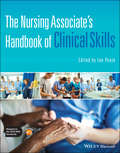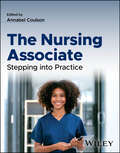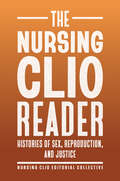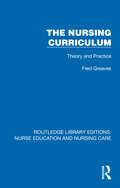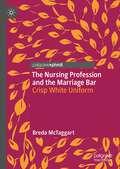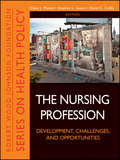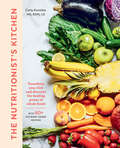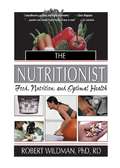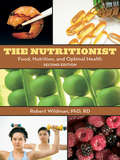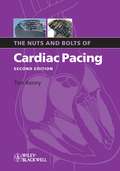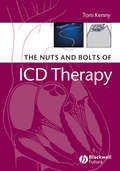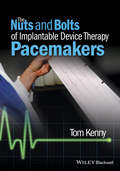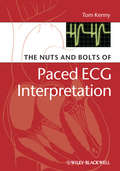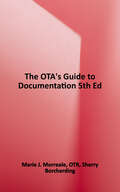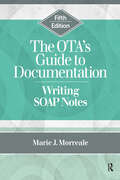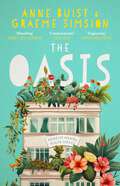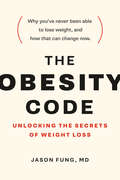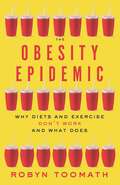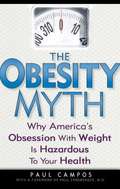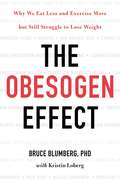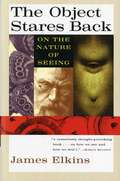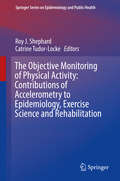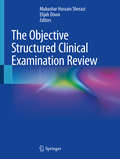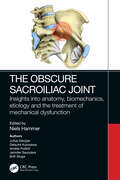- Table View
- List View
The Nursing Associate's Handbook of Clinical Skills
by Ian PeateThe Nursing Associate’s Handbook of Clinical Skills The Nursing Associate’s Handbook of Clinical Skills provides evidence-based guidance for those undertaking the newly developed Nursing Associate (NA) role that bridges the gap between the Health Care Assistant (HCA) and the Registered Nurse (RN). Structured around the latest Nursing and Midwifery Council (NMC) Proficiencies, this invaluable handbook helps the prospective Nursing Associates develop the skills and core competencies required to succeed in a broad range of healthcare contexts—covering more than 90 procedures, and communication and relationship management skills.This timely resource features contributions from a team of experienced clinicians and academics, addressing clinical procedures on topics including skin integrity, nutrition and hydration, mobility and safety, respiratory care, managing infection, administering medicine, and end of life care. Clear, accessible chapters contain a wealth of effective learning tools, including self-assessment tests, review questions, links to electronic resources, supporting evidence, and more. This must-have textbook:Helps trainee Nursing Associates to develop and refine their skills, and demonstrate proficiency in offering care and supportReflects current NMC annexes, providing practical guidance on a diverse range of communication skills, strategies and proceduresCovers the central elements of Nursing Associate care provision, including delivery, monitoring, and reviewingIncludes colour illustrations, photographs, tables, charts, graphs, and algorithms designed to develop skills and demonstrate the links between theory and practicePresenting the principles of care essential for meeting the needs of patients in dynamic health and social care environments, The Nursing Associate’s Handbook of Clinical Skills is an indispensable guide for trainee Nursing Associates, as well as for health and social care assistants and those returning to practice.
The Nursing Associate: Stepping into Practice
by Annabel CoulsonA complete guide to the challenges and opportunities of the nursing associate role, and its potential to improve patient outcomes The Nursing Associate: Stepping into Practice provides essential insights into the important, emerging role of the nursing associate within clinical practice, the importance of professional development, and the core skills and competencies outlined by the Nursing and Midwifery Council (NMC, 2018). This book carefully considers how these skills align with the NMC Standards for Nurse Education and the Future Nurse expectations, and where appropriate, outlines their relationship directly to the Standards of Proficiency. Each chapter includes further reading to enable the reader to expand their understanding in relation to their own experiences and practice needs. The Nursing Associate includes information on: The importance of decision-making, evidence-based practice, and professionalism as a nursing associateApproaches to ensuring a person-centred mindset during admission and the provision of safe and effective careEffective communication skills aimed at supporting individuality, gaining trust, and ensuring the patient voice is recognisedThe relevance of duty of care, candour, equality and diversity, and how the three concepts interlink The transition into becoming a registrant, covering changes in responsibility and accountability level as well as new skill development The Nursing Associate is an essential read for all current and aspiring nursing associates seeking to understand their role, maximise their effectiveness in team support and patient outcomes, and taking the next step in their careers.
The Nursing Clio Reader: Histories of Sex, Reproduction, and Justice (Critical Issues in Health and Medicine)
by Judith Walzer Leavitt Susan M. Reverby Janet Golden Kylie Smith Karen Weingarten Elizabeth Zeman Kolkovich Katrina Kimport Cara Delay Maggie Vinter Lara Freidenfelds Shannon Withycombe Caitlin Reed Wiesner Kirsten Leng Elizabeth Reis Alicia Gutierrez-Romine Brianna Theobald Gillian Frank Nora Doyle Elizabeth Nelson Samantha M. Williams Ciara Breathnach W. Jake Newsome Joseph Gamble Sarah Mellors Rodriguez Averill Earls Elizabeth Garner Masarik Mary Fissell Ronit Stahl Jacqueline D. Antonovich Emily Beckman Cassandra Berman Scottie Hale Buehler John A. Carranza Sara Collini Kathleen Crowther Laura Ansley Catherine Denial Michelle Drew Lea Eisenstein Sarah E. Handley-Cousins Evan Elizabeth Hart Sharon Folkenroth Hess Rebecca M. Kluchin Modupe Labode Ian Lekus Amanda Mahoney Michelle Moravec Lina-Maria Murillo P. Mimi Bhatt Ayah Nuriddin Kelly S. O'Donnell Udodiri Okwandu Sarah Pripas-Kapit J. Nalubega Ross Nina Studer Sarah Swedberg Lauren MacIvor Thompson Stephanie Tillman Felicity M. Turner Theresa Ventura Anna Weerasinghe Cookie Woolner P. Mimi NilesOn June 24, 2022, the Supreme Court’s Dobbs v. Jackson Women’s Health Organization decision overturned Roe v. Wade, stripping federal protection for abortion rights and placing control in the hands of individual states. This monumental shift in policy underscores the need for deeper historical perspectives on reproductive rights. The Nursing Clio Reader answers that call, bringing together essays that examine reproductive health through historical research and personal experience. Featuring both new and classic pieces from the Nursing Clio blog, leading historians of reproductive health provide insights that connect past struggles with today’s ongoing battles over bodies, reproductive rights, and health care. This collection offers intimate, urgent scholarship that speaks to the present moment. A powerful resource for classrooms and individual readers alike, The Nursing Clio Reader invites reflection on how the past informs current debates, urging us to engage deeply with the history of reproductive justice in a time of unprecedented change, underscoring that indeed "the personal is historical."
The Nursing Curriculum: Theory and Practice (Routledge Library Editions: Nurse Education and Nursing Care)
by Fred GreavesOriginally published in 1987, this book expands and develops some of the ideas presented in the author’s earlier volume Nurse Education and the Curriculum: A Curricular Model. This book expands that theoretical discussion and presents an analytical explanation of curriculum design, development and evaluation as applied to nursing. It also addresses the practical difficulties of building and implementing an effective curriculum for nursing education and discusses ways and means by which the facilitation of planning strategies can be developed. The book shows how the curriculum process can be used as a conceptual framework for dealing with intentions and purpose, content, methods and evaluation.
The Nursing Profession and the Marriage Bar: Crisp White Uniform
by Breda McTaggartThis book explores Ireland's Marriage Bar, examining its impact on women's lives and the predominantly feminised nursing profession. Information on the history of nursing and the evolution of the nursing profession tends to focus on critical events or key persons who shaped the profession. What is less known and explored is the women nurses' work experiences or how the world outside the ward affected the nurse and the nursing profession at moments in time. This book takes one of these moments in time, the period of the Marriage Bar, and examines the women nurses' lives and the nursing profession during this period of Ireland's history. It does so by adopting a historical perspective and a lived experience perspective of women who had to negotiate this practice. Fifty years on from the Bar removal, as remnants of this time in Ireland's history remain, legislative and constitutional change are required to right the wrongs of the past.
The Nursing Profession: Development, Challenges, and Opportunities (Public Health/Robert Wood Johnson Foundation Anthology #36)
by Stephen L. Isaacs David C. Colby Diana J. MasonThe Nursing Profession: Development, Challenges, and Opportunities is designed to be a resource for those who are interested in or touched by nursing. This book is designed in part to complement the report by the Institute of Medicine on the future of nursing. Readers—whether researchers or practitioners, foundation or government officials, students, or simply lay people interested in nursing—should use this volume to gain a better understanding of the nursing profession and the issues with which those in the field and related fields are grappling. Major topics include: The history of nursing The nursing profession Current issues and challenges, including the nursing shortage, educating and training nurses, utilizing advanced practice nurses to their fullest, quality and cost, long-term care, community-based care, gender and power, and new areas for nursing A vision for the future The book begins with a comprehensive review of the nursing field by Diana Mason, the Rudin Professor of Nursing at the Hunter-Bellevue School of Nursing, City University of New York, and former Editor-in-Chief of the American Journal of Nursing. Mason’s chapter is followed by reprints of twenty-five of the most influential or significant articles on nursing—some of them classic pieces dating back to Florence Nightingale, others presenting more current thinking on critical issues. This kind of source material is rarely found in one place.
The Nutrition Detective: A Woman's Guide to Treating Your Health Problems Through the Foods You Eat
by Nan Kathryn FuchsThe author proposes yet another diet to conquer the common health problems which are unique to women. Includes recipes, diet plans, and questions to help the reader determine cravings and nutritional needs.
The Nutritionist's Kitchen: Transform Your Diet and Discover the Healing Power of Whole Foods
by Carly KnowlesThe ultimate guide to healthy meals with the healing benefits of whole foods and the latest science-backed nutritional guidelines.With more than 60 seasonal recipes that celebrate invigorating and restorative foods, The Nutritionist&’s Kitchen offers an approachable guide to support optimal health and wellness through everyday meals. Learn from Carly Knowles, registered dietitian nutritionist, who shares her expertise to support you on your health journey.Organized by season, this book includes recipes like Yellow Pumpkin Curry with Toasted Cashews, Wheat Berry Salad with Butternut Squash and Maple Vinaigrette, Baby Spinach and Spring Onion Frittata with Goat Cheese, Salt and Pepper Grilled Prawns with Chimichurri Corn, and Blueberry Açaí and Coconut Ice Pops. Each recipe contains a descriptive food-as-medicine themed headnote including valuable health information. Revitalize your meal planning with this accessible cookbook and find trustworthy nutrition information and wholesome recipes based on the latest scientific recommendations.
The Nutritionist: Food, Nutrition, and Optimal Health
by Robert WildmanUse this valuable book to make better food/diet/nutrition supplement choices for your clients (and yourself)!The Nutritionist provides an overview of the basic concepts involved in nourishing the human body in an organized and progressive first-person question-and-answer format. Its eminently readable style and easy-to-understand graphics will enhance your comprehension of applied nutrition topics such as energy nutrients, vitamins, and minerals as well as energy metabolism and body composition, exercise, heart disease, and cancers.Healthcare professionals, personal trainers, nutritionists, and lay readers will all find valuable, easily understood information in The Nutritionist. The book lays the foundation with a review of the basic concepts of body composition and related scientific concepts, which are invaluable in understanding the nutrition information that follows. It examines molecules, chemical reactions, energy, acids and bases (pH), free radicals and oxidation, and water solubility. With this foundation, concepts such as lipoproteins (LDL, HDL, blood cholesterol), antioxidants, energy, metabolism, body composition, exercise, heart disease, and cancer are easily understandable.This unique book’s first-person, question-and-answer style brings you quick access to current information about nutrition and: energy metabolism energy nutrients weight control body composition exercise vitamins and minerals nutrition supplements osteoporosis diabetes mellitus heart disease cancer and more!The Nutritionist provides straightforward answers to basic questions about the body and how to nourish it. Use it to make better choices for your clients and to help them reach the performance and health goals they set.
The Nutritionist: Food, Nutrition, and Optimal Health, 2nd Edition
by Robert E.C. WildmanNow in an updated and expanded new edition, The Nutritionist: Food, Nutrition, and Optimal Health, 2nd Edition, provides readers with vital information about how to simply but radically improve their daily lives with the science of nutrition, balance their diets to achieve more energy, and improve health and longevity. Complete with many informative and easy-to-read tables and charts, The Nutritionist: Food, Nutrition, and Optimal Health, 2nd Edition, utilizes the findings of the latest biological and medical studies to give experts and non-experts alike a comprehensive account of the needs of our bodies and the ways that healthy eating can improve performance in day-to-day activities. Author Dr. Robert Wildman, renowned nutrition expert, debunks myths about carbohydrates, fat, and cholesterol, elucidates the role of water in nutrition, and clearly explains the facts of human anatomy and physiognomy, the process of digestion, and vitamin supplements. Complete with a practical and comprehensive guide to the nutrition information printed on the packaging of most food items, The Nutritionist: Food, Nutrition, and Optimal Health, 2nd Edition is a necessary and extremely useful nutrition resource for anyone interested in the science and practical benefits of good nutrition.
The Nuts and Bolts of Cardiac Pacing (Nuts and Bolts Series (Replaced by 5113) #11)
by Tom KennyWhile there are many excellent pacing and defibrillation books, they are nearly all written by physicians for physicians. The second edition of the successful The Nuts and Bolts of Cardiac Pacing has been thoroughly updated, reflecting the new challenges, issues, and devices that clinicians deal with. Written specifically for non-cardiologists in a lively, intelligent and easy to follow style, it emphasizes real-life clinical practice and practical tips, including illustrations from actual clinical settings. Each chapter concludes with a checklist of key points from each subject ("Nuts and Bolts"). New features to the second edition include: updated terminology and images reflecting new software developments information on new innovations and advanced features, such as ventricular intrinsic preference and AF suppression new features on the automatic atrial capture test and follow-up features new chapter covering clinical studies on the possible dangers of excessive RV pacing Building layer by layer on the fundamental principles and concluding with advanced concepts, The Nuts and Bolts of Cardiac Pacing is intended for a novice to appreciate overall concepts and for a seasoned veteran to turn to answer a specific question. This book offers practical, reliable and objective information on cardiac devices – it's easy to pick up, find what you need, and put down.
The Nuts and Bolts of ICD Therapy (Nuts and Bolts Series (Replaced by 5113) #9)
by Tom KennyThe number of ICD patients is increasing sharply, yet the number of electrophysiologists—physicians who specialize in the electrical system of the heart—is not increasing as dramatically. The result of this influx is that more and more ICD patients are being treated by physicians and staff with little or no ICD training. There are many fine books on device-based therapy for the heart, but most are written for the experts. Whether you read it from cover-to-cover or use it for reference (or both), it is written primarily with you in mind – for people who are actually involved in the clinical care of these patients. The Nuts and Bolts of ICD Therapy is specifically written for non-cardiologists. This book is written in a lively intelligent and easy to navigate style. It emphasizes real-life clinical practice and practical tips, including illustrations from actual clinical settings. Each chapter concludes with a checklist of key points from each subject (“Nuts and Bolts”).
The Nuts and Bolts of Implantable Device Therapy
by Tom KennyTom Kenny, one of the best-known and well-respected educators in EP brings his signature style to this new primerPractical, accessible, highly illustrated approach makes learning easyProvides an overview of the algorithms and devices offered by the world's five pacemaker manufacturersOffers clinicians learning objectives, test questions and essential points in bulleted listsPerfect introductory guide to the topic, assumes little baseline knowledge and appropriate for residents, fellows, EP nurses, general clinical cardiologists, EP fellows and industry professionals
The Nuts and bolts of Paced ECG Interpretation (Nuts and Bolts Series (Replaced by 5113) #10)
by Tom KennyNothing is more perplexing to the clinician new to device therapy than having to deal with cardiac electrocardiograms from a device patient. Pacemakers and other implantable cardiac rhythm management devices leave their “imprint” on ECGs and can significantly change what clinicians see - or expect to see. Evaluating paced ECGs can be challenging, yet nowhere is it taught in any sort of comprehensive manner. Designed specifically for clinicians new to device therapy, The Nuts and Bolts of Interpreting Paced ECGs and EGMs offers practical, reliable and objective information on paced cardiac electrograms. Written in a lively, intelligent and easy to navigate style, emphasizing real-life clinical practice and practical tips, this book includes illustrated paced ECGs by skilled artists to help minimize “fuzzy” lines and emphasize key points. Each chapter concludes with a checklist of key points from each subject (“Nuts and Bolts”).
The OTA's Guide to Documentation: Writing SOAP Notes
by Marie MorrealeThe bestselling, newly updated occupational therapy assistant (OTA) textbook, The OTA’s Guide to Documentation: Writing SOAP Notes, Fifth Edition explains the critical skill of documentation while offering multiple opportunities for OTA students to practice documentation through learning activities, worksheets, and bonus videos. The Fifth Edition contains step-by-step instruction on occupational therapy documentation and the legal, ethical, and professional documentation standards required for clinical practice and reimbursement of services. Students and professors alike can expect the same easy-to-read format from previous editions to aid OTAs in learning the purpose and standards of documentation throughout all stages of the occupational therapy process and different areas of clinical practice. <p><p> Essentials of documentation, reimbursement, and best practice are reflected in the many examples presented throughout the text. Worksheets and learning activities provide the reader with multiple opportunities to practice observation skills and clinical reasoning, learn documentation methods, create occupation-based goals, and develop a repertoire of professional language. <p><p> Templates are provided to assist beginning OTA students in formatting occupation-based SOAP notes, and the task of documentation is broken down into smaller units to make learning easier. Other formats and methods of recording client care are also explained, such as the use of electronic health records and narrative notes. This text also presents an overview of the initial evaluation process delineating the roles of the OT and OTA and guidelines for implementing appropriate interventions. <p><p> New in the Fifth Edition: <p> • Incorporation of the Occupational Therapy Practice Framework: Domain and Process, Fourth Edition and other updated American Occupational Therapy Association documents <p> • Updated information to meet Medicare Part B and other third-party payer requirements <p> • Revised clinical terminology on par with current trends <p> • Added examples from emerging practice areas <p> • Expanded tables along with new worksheets and learning activities <p><p>Instructors in educational settings can visit www.efacultylounge.com for an Instructor’s Manual and bonus videos to be used in the classroom. Also included with the book is access to a supplemental website for students with to be used in the classroom. Also included with the book is access to a supplemental website worksheets, learning activities, and scenario-based videos to practice the documentation process.
The OTA’s Guide to Documentation: Writing SOAP Notes
by Marie MorrealeThe bestselling, newly updated occupational therapy assistant (OTA) textbook, The OTA’s Guide to Documentation: Writing SOAP Notes, Fifth Edition explains the critical skill of documentation while offering multiple opportunities for OTA students to practice documentation through learning activities, worksheets, and bonus videos.The Fifth Edition contains step-by-step instruction on occupational therapy documentation and the legal, ethical, and professional documentation standards required for clinical practice and reimbursement of services. Students and professors alike can expect the same easy-to-read format from previous editions to aid OTAs in learning the purpose and standards of documentation throughout all stages of the occupational therapy process and different areas of clinical practice.Essentials of documentation, reimbursement, and best practice are reflected in the many examples presented throughout the text. Worksheets and learning activities provide the reader with multiple opportunities to practice observation skills and clinical reasoning, learn documentation methods, create occupation-based goals, and develop a repertoire of professional language.Templates are provided to assist beginning OTA students in formatting occupation-based SOAP notes, and the task of documentation is broken down into smaller units to make learning easier. Other formats and methods of recording client care are also explained, such as the use of electronic health records and narrative notes. This text also presents an overview of the initial evaluation process delineating the roles of the OT and OTA and guidelines for implementing appropriate interventions.New in the Fifth Edition: Incorporation of the Occupational Therapy Practice Framework: Domain and Process, Fourth Edition and other updated American Occupational Therapy Association documents Updated information to meet Medicare Part B and other third-party payer requirements Revised clinical terminology on par with current trends Added examples from emerging practice areas Expanded tables along with new worksheets and learning activities Included with the text are online supplemental materials for faculty use in the classroom, this includes: access to supplemental website worksheets, learning activities, and scenario-based videos to practice the documentation process.
The Oasis: Menzies Mental Health Novel 2 (Menzies Mental Health)
by Graeme Simsion Anne BuistBy the bestselling authors of The Glass House, Anne Buist & Graeme Simsion, comes the second novel in the groundbreaking Menzies Mental Health seriesTrainee psychiatrist Doctor Hannah Wright has only just got her head above water in the acute psychiatric ward at Menzies Hospital when she's thrown into the deep end of the outpatient clinic. Keen to develop her skills in talking therapies, she finds herself up against a boss who's focused on medication and a senior colleague with a score to settle.Hannah's fellow first-years face problems of their own: on-and-off flame Alex is being bullied, Ndidi's marriage is in trouble, Jon feels isolated and Carey is concerned their autism will be a career barrier.While Hannah comes under pressure to seek therapy herself to confront a traumatic past, her patients' health issues range from OCD to ice addiction, childhood abuse to the mental impact of ageing, and from bad parenting to bad genes. They all come to the Oasis.Written with great humanity and humour, Australian psychiatrist Anne Buist and internationally bestselling author Graeme Simsion (The Rosie Project) welcome us into the world of mental health with compassion and insight. Praise for The Glass House'A masterfully told, character-driven novel that will have you laughing and crying in equal measures' THE AUSTRALIAN 'A deeply empathetic, humanising portrait of a mental health facility, and the souls that pass through it' THE AUSTRALIAN WOMEN'S WEEKLY'Stunning . . . So timely' DAILY TELEGRAPH'Absorbing' INSTYLE AUSTRALIA'A darn good read' LIVING ARTS CANBERRA'Brings alive the frontline of mental health care' PROFESSOR PATRICK MCGORRY AO, AUSTRALIAN OF THE YEAR 2010 'Overflows with compassion, insight and humour' MEREDITH JAFFÉ 'Gripping, rich and insightful' ARIANE BEESTON, author of Because I'm Not Myself, You See 'Anne Buist skilfully writes from her own experiences and co-author Graeme Simsion adds his inimitable Rosie Project style. An honest, sensitive look into mental health care in Australia' PROFESSOR JAYASHRI KULKARNI AM, Psychiatrist, Monash University
The Obesity Code: Unlocking the Secrets of Weight Loss
by Timothy Noakes Dr Jason FungEverything you believe about how to lose weight is wrong. Weight gain and obesity are driven by hormones-in everyone-and only by understanding the effects of insulin and insulin resistance can we achieve lasting weight loss.In this highly readable and provocative book, Dr. Jason Fung sets out an original, robust theory of obesity that provides startling insights into proper nutrition. In addition to his five basic steps, a set of lifelong habits that will improve your health and control your insulin levels, Dr. Fung explains how to use intermittent fasting to break the cycle of insulin resistance and reach a healthy weight-for good.
The Obesity Epidemic: Why Diets and Exercise Don't Work—and What Does
by Robyn ToomathWhy modern life makes it almost impossible for people to lose weight and keep it off.In a world where charlatans promise to fix the alarming obesity epidemic with a silver-bullet diet or trendy new exercise program, Robyn Toomath, a physician and realist, steps out of the fray to deliver some tough news: it’s really hard to lose weight. Dispelling common myths and telling provocative truths about weight gain—and loss—The Obesity Epidemic is an engaging investigation into the complicated factors that lead to obesity. While genes certainly play a part, Toomath argues, more people are fat than ever before because most of us consume significantly more calories than we did 30 years ago. But why? The answer, she asserts, is the commodification of food created by junk food advertising coupled with urbanization, globalization, and trade agreements. And while government, advertisers, gyms, and the weight loss industry keep pushing solutions that science shows do not work—from extreme exercise regimens and fad dieting to prohibitively expensive surgeries, pills, and misguided education campaigns—Toomath outlines what just might make a difference in terms of helping people truly control their weight.Drawing on the latest research and her twenty years of working with overweight patients, Dr. Toomath argues that even strongly determined people who are offered appealing incentives typically cannot lose weight permanently. Instead of demonizing people by treating weight as an issue of personal or even moral responsibility, Dr. Toomath makes it clear that nothing will change until we make it easy, not all but impossible, for people to eat healthily. Raising important questions about obesity, Toomath sidesteps the standard sound bites and puts an end to the myth of personal responsibility for body size by focusing on the environment all around us.
The Obesity Myth: Why America's Obsession with Weight is Hazardous to Your Health
by Paul CamposThe Obesity Myth should be required reading for every health professional in America. I believe any open-minded person who reads this book will conclude that we have been duped by a pack of self-serving lies.
The Obesogen Effect: Why We Eat Less And Exercise More But Still Struggle To Lose Weight
by Kristin Loberg Bruce BlumbergAn eye-opening account of the landmark research into the hidden chemicals that are endangering our health and keeping us fatBeing overweight is not just the result of too many cheeseburgers or not enough exercise. According to leading-edge science, there are silent saboteurs in our daily lives that contribute greatly to our obesity epidemic: obesogens. These weight-inducing offenders, most of which are chemicals, disrupt our hormonal systems, alter how we create and store fat, and change how we respond to dietary choices. Because they are largely unregulated, obesogens lurk all around us-in food, furniture, plastic products such as water bottles and food storage containers, and other surprising exposure points. Even worse: research has shown that the effects of some obesogens can be passed on to future generations by irreversibly interfering with the expression of our genes. The good news is we can protect ourselves by becoming more informed consumers. In THE OBESOGEN EFFECT, Dr. Bruce Blumberg describes how obesogens work, reveals where they are found, and offers a practical three-step solution for reducing exposures. He explains why one size does not fit all in a weight loss program, what hides in our household goods, and how we should shop for items we buy every day-from vegetables and meats to canned soup as well as household cleaners, air fresheners, and personal care products. THE OBESOGEN EFFECT is an urgent call to action to protect your body, clean up your life, and set a straight course for better health.
The Object Stares Back: On The Nature Of Seeing
by James ElkinsAt first it appears that nothing could be easier than seeing. We just focus our eyes and take in whatever is before us. This ability seems detached, efficient and rational - as if the eyes were competent machines telling us everything about the world without distorting it in any way. But those ideas are just illusions, James Elkins argues, and he suggests that seeing is undependable, inconsistent and cauthg up in the threads of the unconscious. Blindness is not the opposite of vision, but its constant companion, and even the foundation of seeing itself. Using drawings, paintings, diagrams and photographs to illustrate his points, Elkins raises intriguing questions and offers astonishing perceptions about the nature of vision.
The Objective Monitoring of Physical Activity: Contributions of Accelerometry to Epidemiology, Exercise Science and Rehabilitation
by Roy J. Shephard Catrine Tudor-LockeThis book examines the new knowledge that has been gained from the objective monitoring of habitual physical activity by means of pedometers and accelerometers. It reviews current advances in the technology of activity monitoring and details advantages of objective monitors relative to physical activity questionnaires. It points to continuing gaps in knowledge, and explores the potential for further advances in the design of objective monitoring devices. Epidemiologists have studied relationships between questionnaire assessments of habitual physical activity and various medical conditions for some seventy years. In general, they have observed positive associations between regular exercise and good health, but because of inherent limitations in the reliability and accuracy of physical activity questionnaires, optimal exercise recommendations for the prevention and treatment of disease have remained unclear. Inexpensive pedometers and accelerometers now offer the epidemiologist the potential to collect relatively precisely graded and objective information on the volume, intensity and patterns of effort that people are undertaking, to relate this data to past and future health experience, and to establish dose/response relationships between physical activity and the various components of health. Such information is important both in assessing the causal nature of the observed associations and in establishing evidence-based recommendations concerning the minimal levels of daily physical activity needed to maintain good health.
The Objective Structured Clinical Examination Review
by Elijah Dixon Mubashar Hussain SheraziThis review book comprehensively covers most aspects of the Objective Structured Clinical Examination (OSCE). Each chapter provides a meticulous overview of a topic featured in the OSCE, including general surgery, pediatrics, psychiatry, obstetrics and gynecology, gastroenterology, geriatrics, hematology, and ethics. Common scenarios for each topic are featured in every chapter, accompanied by instructions and tips on how to take a patient's history, diagnose a patient, discuss treatment options, and address patient concerns under each scenario. Possible areas of difficulty, common candidate mistakes made, and important differential diagnosis are outlined in each chapter. The text is also supplemented with check-lists, photographs, and tables for enhanced readability and ease of use. Written by experts in their respective fields, The Objective Structured Clinical Examination Review is a valuable resource for medical students and residents preparing for the OSCE.
The Obscure Sacroiliac Joint: Insights into anatomy, biomechanics, etiology and the treatment of mechanical dysfunction
by Jennifer Saunders Niels Hammer Julius Dengler Daisuke Kurosawa Amélie Poilliot Britt StugeThis book summarises contemporary basic science understanding of sacroiliac joint anatomy, biomechanics, and disease with related changes in the joint. It provides great insight into emerging and promising therapeutic options. Combining established concepts and recent findings on the sacroiliac joint, together with research advances made over the last 25 years, this illustrated text will appeal to pain therapists, orthopedic practitioners, spine surgeons, sacroiliac joint surgeons, physiotherapists, and general practitioners.
